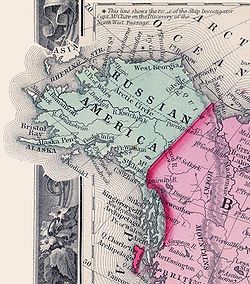Russian America
Russian America (Russian: Русская Америка), was a colonial possession of the Russian Empire in North America between 1799 and 1867, in the current State of Alaska, also included some fortifications, such as Fort Ross in California and four other forts (including Russian Fort Elizabeth) located in Hawaii, its capital would be Novo-Arkhangelsk (current Sitka), this colony would be monopolized by the Russian-American Company and the arrival of the Russian Orthodox Church.[1]
| Russian America Русская Америка Russkaya Amerika | ||||||
| Colony of the Russian Empire | ||||||
| ||||||
| ||||||
| Russian America in 1860 | ||||||
| Capital city | Kodiak (1799–1804) Novo-Arkhangelsk | |||||
| Governor | ||||||
| - | 1799–1818 (first) | Alexander Andreyevich Baranov | ||||
| - | 1863–1867 (last) | Dmitry Petrovich Maksutov | ||||
| History | ||||||
| - | Company Charter[a] | 8 July 1799 | ||||
| - | Alaska Purchase | 18 October 1867 | ||||
| Today part of | United States | |||||
| a. ^ The Russian-American Company was chartered by the Emperor Alexander I in 1799, to govern Russian possessions in North America on behalf of the Russian Empire. | ||||||
This territory prospered due to the fur trade even though it would decline due to logistical difficulties and many settlements would be abandoned in the 1860s, it was finally sold to the United States in 1867 for $7.2 Millions ($120 Millions today)[2]
Russian America Media
God Save The Tsar! Russian national anthem 1833 to 1917. Recorded in 1915. Performed by the chorus and orchestra of St. Petersburg Philharmonic Society
The Bering Strait, where Russia's east coast lies closest to Alaska's west coast. Early Russian colonization occurred well south of the strait, in the Aleutian Islands.
Sibero-Russian promyshlenniki, frontiersmen.
Aleutian & Russian allied forces defeat the Tlingit tribe at the Battle of Sitka, 1804.
Alexander Andreyevich Baranov, called "Lord of Alaska" by Hector Chevigny, played an active role in the Russian–American Company and was the first governor of Russian America.
Russian Orthodox cathedral in present-day Sitka
St.Peter the Aleut, a martyred Aleutian Creole.
References
- ↑ Campbell, Robert (2007). In Darkest Alaska: Travel and Empire Along the Inside Passage. Philadelphia: University of Pennsylvania Press. p. 1. ISBN 978-0-8122-4021-4.
- ↑ Black, Lydia T. (2004). Russians in Alaska, 1732–1867. Fairbanks: University of Alaska Press.
- Grinëv, Andrei V. "Natives and Creoles of Alaska in the maritime service in Russian America." The Historian 82.3 (2020): 328-345.
- Essig, Edward Oliver. Fort Ross: California Outpost of Russian Alaska, 1812–1841 (Kingston, Ont.: Limestone Press, 1991.)
- Gibson, James R. "Old Russia in the New World: adversaries and adversities in Russian America." in European Settlement and Development in North America (University of Toronto Press, 2019) pp. 46-65.
- Gibson, James R. Imperial Russia in frontier America: the changing geography of supply of Russian America, 1784–1867 (Oxford University Press, 1976)
- Vinkovetsky, Ilya. Russian America: an overseas colony of a continental empire, 1804–1867 (Oxford University Press, 2011)










